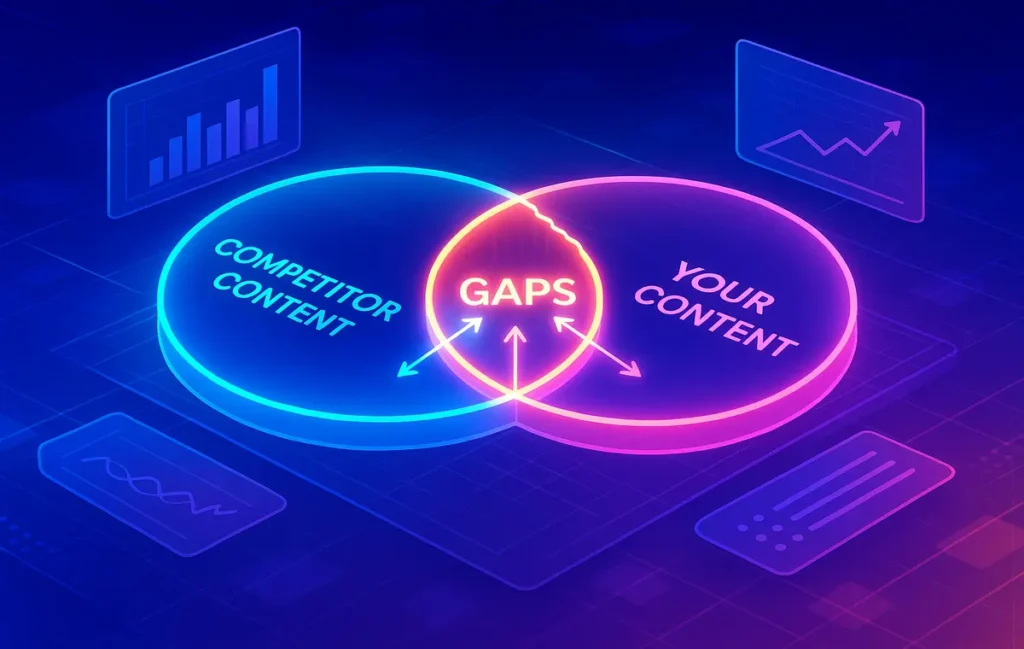🎯 Intro
Why are your competitors ranking while your carefully written content struggles to get traction? The answer often lies in the hidden spaces between what you’ve published and what your audience is actually searching for—those are your content gaps.
A content gap analysis is not about broad keyword research or generic planning. It’s about systematically identifying what your competitors are covering, what users want, and what your site is missing. In this guide, NerdChips breaks down how to run a content gap analysis that actually works, giving you a repeatable framework you can apply quarterly or even monthly.
💡 Nerd Tip: Don’t confuse gap analysis with general keyword brainstorming—it’s a laser-focused method to spot what you’re missing, not a random idea dump.
🔍 What is Content Gap Analysis?
In the simplest terms, content gap analysis is the process of comparing your existing content to what your competitors and your audience expect. It highlights missing topics, keywords, and formats that can drive additional traffic and authority.
This is different from keyword research because it’s contextual. Instead of finding every keyword possible, you focus on the “gaps” that matter: the questions you haven’t answered, the subtopics you’ve skipped, the content formats you haven’t produced.
The importance is twofold:
-
Discovering opportunity: Gaps often represent untapped search volume or questions your competitors are ranking for.
-
Fixing weaknesses: Gaps reveal cannibalization risks where your content overlaps poorly, or intent mismatches where you’re not meeting user needs.
If you’ve read our Ultimate Guide to Using ChatGPT for Keyword Research, think of gap analysis as the next stage: turning keyword data into strategic insights.
🛠️ Tools & Methods to Run It
Running a content gap analysis doesn’t have to be complicated, but it does require reliable data. Tools like Ahrefs, SEMrush, and SimilarWeb allow you to compare your domain against competitors and instantly see keywords they rank for that you don’t.
For a free baseline, Google Search Console reveals queries driving impressions but not clicks—often signs of content that exists but doesn’t fully satisfy intent. Pair this with AI tools like ChatGPT for quick pattern recognition. For example, you can feed competitor blog URLs into an AI and ask it to summarize the topics they cover that you don’t.
Another method is manual comparison. Open competitor pages, map their headings, and contrast with your content outlines. Sometimes the gaps aren’t in keywords but in structure—competitors may add FAQs, case studies, or tools while your post is just text.
💡 Nerd Tip: Don’t just measure keyword presence. Check formats too. If competitors have video explainers or interactive tools, that’s a gap you can close with creative assets.
⚡ Step-by-Step Framework
Step 1: Define Your Competitors
Pick 3–5 direct competitors. These can be domains consistently outranking you, not necessarily your industry rivals.
Step 2: Extract Keyword & Topic Sets
Use tools to pull all ranking keywords from these competitors. Filter by relevance to your core themes.
Step 3: Identify Missing Topics & Intent Gaps
Mark queries or subtopics you haven’t covered. Pay attention to intent—are they publishing guides where you’ve only got listicles? Are they using infographics or tools while you rely solely on text?
Step 4: Map Gaps to a Content Calendar
Translate gaps into future posts, updates, or multimedia assets. For example, if you lack coverage of “AI content marketing platforms,” map it into your Content Calendar and align it with your publishing cycle.
Step 5: Prioritize by ROI
Not all gaps are equal. Use metrics like CPC, keyword difficulty, and expected conversion value to decide what to cover first. Some topics may generate traffic but no revenue; others are goldmines worth prioritizing.
💡 Nerd Tip: Treat your gap analysis output like a roadmap. If you publish randomly, you’ll slip back into guesswork.
📈 The Real ROI of Content Gap Analysis
Why does gap analysis matter so much? Because it delivers measurable impact. A consistent program of gap analysis can increase organic traffic by 20–30% in under six months.
By filling topical gaps, you also strengthen topical authority—Google begins to see your site as a complete resource on your subject. This reduces reliance on one or two “pillar posts” and builds a healthier, distributed traffic profile.
Another ROI point is reducing cannibalization. Without a gap audit, many creators unknowingly write multiple articles competing for the same keyword. A structured analysis ensures each post has a unique angle, as we discussed in our guide on Content Marketing Platforms.
💡 Nerd Tip: Track ROI not only by traffic but by conversions. Filling gaps in product-related content often drives disproportionate sales impact.
🚀 Implementation Case Study
A mid-sized SaaS company applied content gap analysis against three leading competitors. They discovered they had no posts targeting “AI-powered project management” despite the term’s growing CPC and search volume.
By publishing three long-form guides, a video explainer, and updating old posts with internal links, they grew organic traffic by 30% in six months. More importantly, trial sign-ups increased 18% because the gap content directly aligned with customer intent.
This demonstrates that gap analysis isn’t theory—it’s a repeatable framework that works across industries, from SaaS to e-commerce to personal blogs.
⚠️ Challenges & Solutions
No process is perfect. Content gap analysis has challenges:
-
Data accuracy: Different tools show different numbers. Solution: use multiple sources and look for overlap.
-
Too many gaps: It’s tempting to fill them all. Solution: prioritize by business impact and difficulty.
-
Internal overlap: Filling gaps may create near-duplicate content. Solution: use canonical tags, internal linking, and regular audits.
💡 Nerd Tip: Always sanity-check your list of gaps against your own funnel. Not every competitor keyword is worth chasing—only pursue those aligned with your goals.
⚡ Find Your Hidden Content Opportunities
Run a content gap analysis with tools like Ahrefs, SEMrush, or even Google Search Console. Start small, close one gap, and watch your traffic grow.
🧩 Types of Content Gaps Beyond Keywords
Most marketers think of gaps purely in terms of keywords they missed. But the real depth comes when you expand your lens to different dimensions of content.
-
Format Gaps: Maybe you’ve written blogs, but competitors are ranking with videos, infographics, or interactive tools. Search engines now reward variety, and users often prefer visual content. If a rival has a tutorial video embedded where you only have text, that’s a clear gap.
-
Depth Gaps: Sometimes the difference isn’t in topics but in completeness. If your guide is 800 words but your competitor has a 2,500-word deep dive with case studies, Google will often favor theirs. Longer isn’t always better, but comprehensive coverage is.
-
Journey Gaps: Think of the funnel—awareness, consideration, decision, and even post-purchase. If you only publish awareness-level content but your competitor nurtures visitors through every stage, you’re leaving conversion opportunities on the table.
💡 Nerd Tip: Don’t limit your analysis to keywords—map the formats, depth, and funnel stages where your competitors outperform you.
🗂 The Content Mapping Matrix
One of the most effective ways to visualize gaps is a Content Mapping Matrix. Imagine a grid where columns represent the customer journey (awareness, consideration, decision, retention) and rows represent your key themes or clusters.
When you plot your existing content across this matrix, gaps become visible. Perhaps you’ve written five awareness posts about “AI SEO tools” but have no decision-stage comparisons like “AI SEO Tools vs Traditional Platforms.” Or maybe you’ve built lots of content about blog optimization but nothing about repurposing content into videos.
This exercise also prevents cannibalization. Instead of creating multiple posts fighting for the same awareness-level keywords, you can distribute your resources evenly and build a full-funnel content strategy.
💡 Nerd Tip: Review your matrix quarterly. It’s the fastest way to see if you’re overserving some stages while ignoring others.
🤖 Using AI for Faster Analysis
AI tools are game-changers for content gap analysis in 2025. Instead of manually reviewing hundreds of competitor URLs, you can feed them into ChatGPT or similar tools and ask for summaries of their topics, CTAs, and formats. Within minutes, you’ll have a structured comparison.
For example, you might paste ten competitor articles into an AI prompt and ask: “What topics or angles do these cover that my site doesn’t?” The AI will highlight missing FAQs, content structures, or even visual elements.
AI can also cluster keywords faster than traditional tools. While SEMrush or Ahrefs provide raw lists, an AI can group them into intent-based categories—informational, transactional, navigational—helping you prioritize what matters.
💡 Nerd Tip: Use AI not as a replacement for SEO tools, but as a speed booster. Let it surface patterns, then validate with real data from Top SEO Tools and How They’ve Evolved.
🕵️ Competitive Intelligence Layer
Content gap analysis isn’t only about keywords or topics—it’s about understanding the strategic edge your competitors use. Look beyond words on a page:
-
CTAs: Do competitors add free trials, lead magnets, or interactive calculators that you lack? A missing CTA is a revenue gap.
-
Distribution: Are they amplifying their content via newsletters, podcasts, or repurposing into LinkedIn posts? If they’re using tactics outlined in Repurposing Content and you’re not, that’s another gap.
-
Content Experience: Check formatting, visuals, and usability. If a rival uses data visualizations while you only use plain text, they’ll hold attention longer.
By analyzing not just what competitors say but how they deliver and promote it, you uncover actionable insights for your own content playbook.
💡 Nerd Tip: Run a side-by-side page analysis. Compare your blog post to a competitor’s equivalent. Ask: who would I trust more as a reader?
🔮 Future Outlook & Frequency of Gap Analysis
Gap analysis isn’t a one-off exercise—it’s a habit. In 2025 and beyond, it’s becoming even more crucial for three reasons:
-
AI-generated content explosion: With thousands of AI-assisted posts flooding the web, quality differentiation matters more than ever. Gap analysis helps you spot where AI-heavy competitors are generic, so you can add human expertise.
-
Search engine evolution: Google and others are increasingly rewarding topical authority. If you fail to close gaps, algorithms will treat your site as incomplete.
-
Audience expectations: Readers now expect mixed formats and depth. If you’re missing videos, interactive tools, or updated stats, you’ll lose credibility.
As for frequency: small sites should run gap analysis at least twice per year. Competitive industries demand quarterly reviews. For fast-moving niches like AI, monthly spot-checks keep you ahead.
💡 Nerd Tip: Treat gap analysis as routine maintenance, like SEO hygiene. Skipping it too long is like never changing the oil in your car—it’ll run, but not for long.
📬 Want More Smart SEO Tips?
Join our free newsletter for weekly insights on SEO tools, content workflows, and AI strategies—delivered straight from NerdChips to your inbox.
🔐 100% privacy. Just actionable strategies, no spam.
🧠 Nerd Verdict
Content gap analysis is the roadmap your content strategy has been missing. Without it, you’re publishing in the dark, hoping for results. With it, you gain a systematic way to discover opportunities, reduce wasted effort, and align content directly with demand.
At NerdChips, we see gap analysis as the foundation of scalable SEO. Whether you’re a solopreneur or a content team, it’s the single most reliable process to keep your content relevant, competitive, and profitable.
❓ FAQ: Nerds Ask, We Answer
💬 Would You Bite?
When was the last time you compared your content directly against competitors?
If you ran a gap analysis today, what hidden growth opportunities would you uncover? 👇
Crafted by NerdChips for creators who want to fill the gaps and own their niche.



